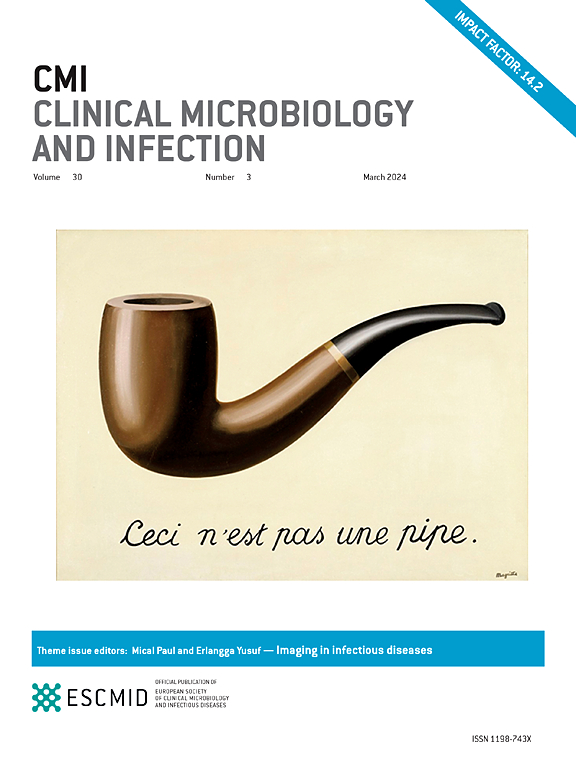延长输注β-内酰胺类抗生素治疗血液病患者发热性中性粒细胞减少症的疗效(BEATLE):一项随机、多中心、开放标签、优势临床试验。
IF 10.9
1区 医学
Q1 INFECTIOUS DISEASES
引用次数: 0
摘要
目的:延长输注(EI)β-内酰胺类抗生素对发热性中性粒细胞减少症的疗效尚不明确。我们评估了在治疗发热性中性粒细胞减少症时,延长输注β-内酰胺类抗生素是否比间歇输注(II)更有效:我们在四家西班牙大学医院对发热性中性粒细胞减少症患者进行了随机、开放标签、优效性临床试验。接受造血干细胞移植或接受化疗的急性白血病患者因发热性中性粒细胞减少症而需要经验性抗生素治疗时,我们将其随机分配(1:1),在首剂栓剂后接受β-内酰胺类或II类抗生素的EI治疗。抗伪β-内酰胺的选择由主治医生决定。主要终点是第 5 天的治疗成功率,即在不改变抗生素治疗方案的情况下,患者病情得到缓解。次要终点包括不良事件、达到药代动力学/药效学目标 50、75 和 100%ƒuT>MIC 以及 30 天死亡率:在2019年11月19日至2022年6月22日期间,我们筛选了295名符合条件的患者,其中150人被随机分配接受EI(77人)或II(73人)抗假性β-内酰胺类药物的治疗。在意向治疗分析中,接受 EI 治疗的第 5 天成功率为 39/77 例患者(50.6%),而接受 II 治疗的第 5 天成功率为 46/73 例患者(63.0%)(风险差异为-12.4%;95% 置信区间为-29.4 至 4.7,P=0.17)。EI组患者更容易达到经验治疗的药代动力学/药效学目标,即75%和100% ƒuT>MIC。在不良事件或 30 天死亡率方面,各组之间没有发现显著的统计学差异:我们的研究结果不支持在发热性中性粒细胞减少症中常规使用经验性β-内酰胺类药物 EI。进一步的研究应考虑发热性中性粒细胞减少症的临床异质性,并重点关注败血症/败血症性休克和有微生物感染记录的患者,尤其是那些由对β-内酰胺类药物敏感性较低的微生物引起感染的患者。本文章由计算机程序翻译,如有差异,请以英文原文为准。
Efficacy of extended infusion of β-lactam antibiotics for the treatment of febrile neutropenia in haematologic patients (BEATLE): a randomized, multicentre, open-label, superiority clinical trial
Objectives
The efficacy of extended infusions (EI) of β-lactam antibiotics for optimising outcomes in febrile neutropenia is unclear. We assessed whether the administration of β-lactams was more effective in EI than in intermittent infusion (II) for the treatment of febrile neutropenia.
Methods
We performed a randomized, open-label, superiority clinical trial of patients with febrile neutropenia at four Spanish university hospitals. Patients undergoing haematopoietic stem cell transplantation or with acute leukaemia receiving chemotherapy who required empirical antibiotic treatment for febrile neutropenia were randomly assigned (1:1) to receive EI of β-lactam or II after a first dose in bolus. The choice of antipseudomonal β-lactam was left to the discretion of the attending physician. The primary endpoint was treatment success at day 5, defined as defervescence without modifying the antibiotic treatment. Secondary endpoints included adverse events, attainment of the pharmacokinetic/pharmacodynamic target of 50%, 75%, and 100%ƒuT > MIC, and 30-day mortality.
Results
From November 19, 2019 to June 22, 2022, 295 patients were screened for eligibility, of whom 150 were randomly assigned to receive EI (n = 77) or II (n = 73) of the antipseudomonal β-lactam of choice. In the intention-to-treat analysis, treatment success at day 5 was achieved in 39/77 patients (50.6%) receiving EI versus 46/73 patients (63.0%) receiving II (risk difference, −12.4%; 95% CI, −29.4 to 4.7; p 0.17). The pharmacokinetic/pharmacodynamic targets of 75% and 100% ƒuT > MIC for empirical treatment were achieved more frequently in the EI group. No statistically significant differences were found between groups in terms of adverse events or 30-day mortality.
Discussion
Our findings do not support the routine use of empirical EI of β-lactams in febrile neutropenia. Further studies should consider the clinical heterogeneity of febrile neutropenia and focus on patients with sepsis or septic shock and microbiologically documented infections, particularly those with infections caused by microorganisms less susceptible to β-lactams.
求助全文
通过发布文献求助,成功后即可免费获取论文全文。
去求助
来源期刊
CiteScore
25.30
自引率
2.10%
发文量
441
审稿时长
2-4 weeks
期刊介绍:
Clinical Microbiology and Infection (CMI) is a monthly journal published by the European Society of Clinical Microbiology and Infectious Diseases. It focuses on peer-reviewed papers covering basic and applied research in microbiology, infectious diseases, virology, parasitology, immunology, and epidemiology as they relate to therapy and diagnostics.

 求助内容:
求助内容: 应助结果提醒方式:
应助结果提醒方式:


